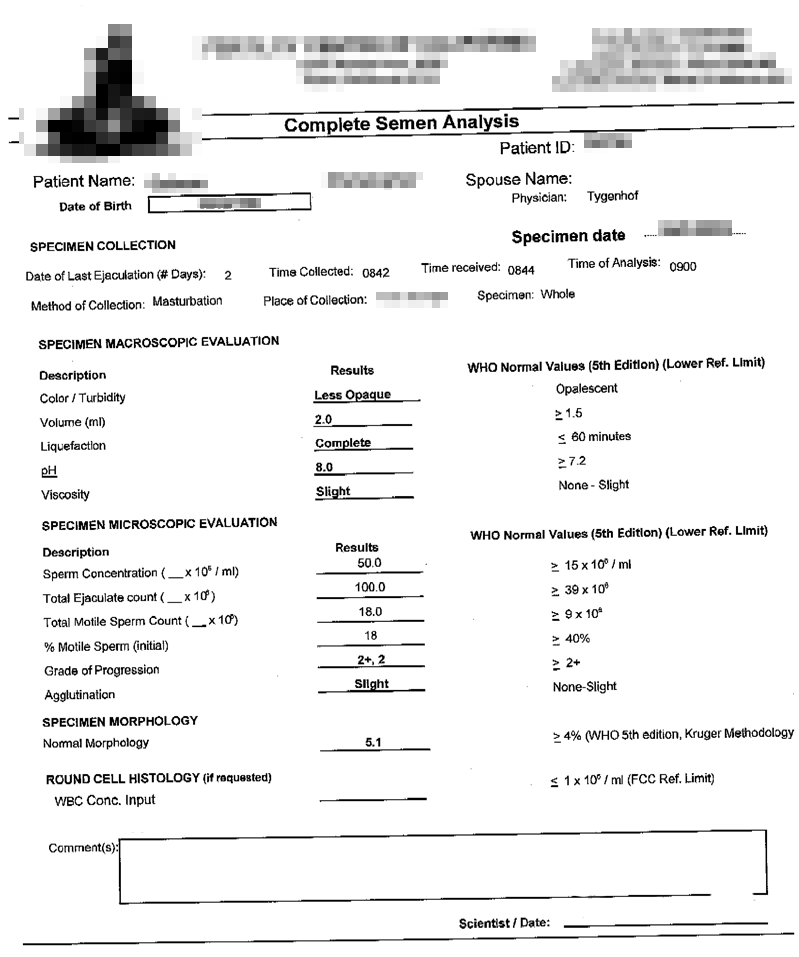This is what a typical semen analysis report looks like. If you provided a good specimen and had the same findings on two separate specimens then these results should be accurate. I also have some information for you on the basics of infertility.
The semen analysis

The first thing to understand is that semen and sperm are different things. Sperm are the little swimmers that penetrate the egg for fertilization. Semen is the entire liquid that is produced with ejaculation. Not all semen will have sperm, but all sperm is in semen (for the most part).
Color
The first thing we see is the color. Certain discolorations could suggest blood or infection. Certain foods and medications can also cause a change in color. An abnormal color may mean some additional tests are needed, such as PSA testing, urine testing, or culture of the semen.
Volume
Next is volume. This is the total amount of fluid you produced when you ejaculated into the cup. A high volume means nothing. A low volume usually, though not always, means that the fluid is being blocked or going in the wrong direction. If you have a low volume your doctor will often ask you to repeat the test and then collect your urine to see if the semen is passing into your bladder instead of out of the penis. This could be due to some nerve problems, medications, or surgeries.
Liquefaction
Liquefaction is how rapidly the semen gel turns into a liquid. Infections and dehydration can cause abnormal liquification. This process relies on certain enzymes in the semen, so if those enzymes are abnormal due to genetic issues that could be another cause.
pH
The pH of the semen should be greater than 7.2. A high pH could indicate infection. A low pH could indicate blockage of the seminal vesicles. An abnormal pH affects the sperm and the enzymes in the semen.
Viscosity
Viscosity of the semen can relate to infection or oxidative stress. It’s a measure of how thick or watery the semen is. Oxidative stress is when too many free radicals, or damaging particles, are present in the semen. If this is the case for you your doctor may recommend antioxidants such as vitamin C or E. When the semen is too thick it can inhibit the movement of sperm.
Sperm concentration
Sperm concentration is very important. When low this could mean that the sperm are being blocked from getting from the testicle to the penis, or that the testicles aren’t making enough sperm. You may hear the terms oligospermia and azoospermia. Oligospermia is a low sperm concentration and azoospermia is no sperm.
Sperm total count
The total count is the concentration multiplied by the volume. It gives a sense of the overall picture. Gallons of semen with no swimmers is useless, just like a drop of semen with millions of swimmers is useless.
Sperm motile count
The motile count is the sperm concentration multiplied by the volume multiplied by the percent motility. Along with the percent motility, these values give us a sense of how well the sperm you have are functioning. Having swimmers is good, but if they aren’t moving they aren’t useful. Low motility can be related to varicocele, diet, excessive heat to the scrotum (like hot tubs), obesity, and certain toxins.
Progression
Progression tells us how well the moving sperm swim. Are they moving in straight lines or just swimming in circles? If they can’t progress forward they’ll never find the egg to bind and penetrate. Poor progression can be due to abnormal genetics, smoking, and varicocele.
Agglutination
When the sperm clump together abnormally this is called agglutination. The sperm want to be free solo swimmers, but when they’re stuck together they can’t move. It’s like trying to run a three-legged race. Most commonly this clumping is due to anti-sperm antibodies, which occur when the body’s immune system targets the sperm.
Morphology
The final component is the morphology, or how normal do the sperm look. Sperm with abnormal heads aren’t able to penetrate the outer layer of the egg. These sperm are also frequently found to contain abnormal DNA. Abnormal morphology can be due to abnormal genetics of the male, which cannot be fixed. Other causes can include toxic exposures and increased temperature, both of which can be improved. Depending on the findings on your analysis your doctor may ask for additional tests or recommend additional procedures.

2 Replies to “Understanding Your Semen Analysis”